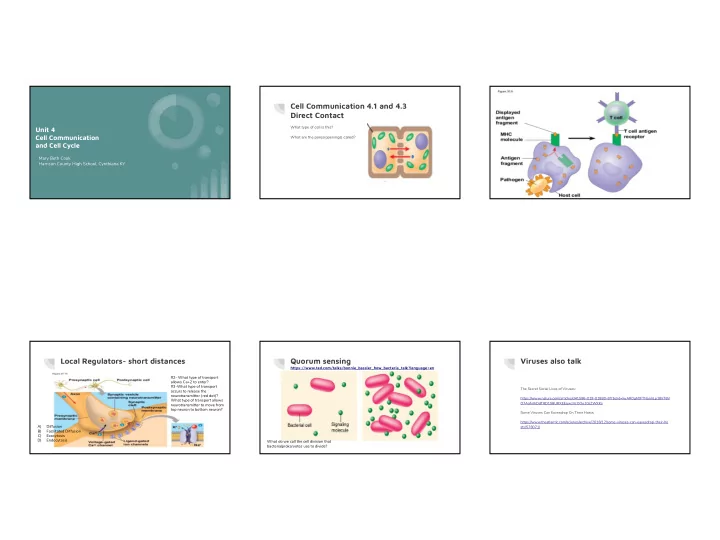

Cell Communication 4.1 and 4.3 Direct Contact What type of cell is this? Unit 4 Cell Communication What are the pores(openings) called? and Cell Cycle Mary Beth Cook Harrison County High School, Cynthiana KY Local Regulators- short distances Quorum sensing Viruses also talk https://www.ted.com/talks/bonnie_bassler_how_bacteria_talk?language=en #2- What type of transport allows Ca+2 to enter? #3-What type of transport The Secret Social Lives of Viruses: occurs to release the neurotransmitter (red dot)? https://www.nature.com/articles/d41586-019-01880-6?fbclid=IwAR0gh0FTNanJiLp1BIiT6V What type of transport allows O7AahiJhDdT8D158URXEEqwzVcOOe10sZWXKs neurotransmitter to move from top neuron to bottom neuron? Some Viruses Can Eavesdrop On Their Hosts: https://www.theatlantic.com/science/archive/2018/12/some-viruses-can-eavesdrop-their-ho A) Diffusion sts/578071/ B) Facilitated Diffusion C) Exocytosis D) Endocytosis What do we call the cell division that bacteria/prokaryotes use to divide?
What are the 3 steps in a signal transduction pathway? Long distance communication- Signal Transduction Pathway 4.2 & 4.3 Using #’s in this diagram, identify which hormones number/numbers are What are two other associated with that step. names for lipid-soluble? What are two other names for water-soluble? Why is this signal able to cross the Why is the signal not able membrane? to cross the membrane? Membrane bound receptors Transduction-Phosphorylation Cascade What is the response occurring in both of these pictures? Monomer: Bond: Reaction:
ANSWER- Mean 2.68+/- 2.33 out of 10
Answer continued 4.4 Changes in Signal Transduction Pathways Mutations in DNA can affect different portions of a receptor protein, depending on where the mutation occurred. If mutation occurs in the ligand binding site, ligand can no longer bind and cell no longer can respond to that signal. If mutation occurs on intracellular side of protein, the change in shape could either lead to a different unintended cellular response, or to no response, because this shape doesn’t activate the next step in transduction. 4.5 Feedback- maintain internal environment and Positive Feedback- Oxytocin Negative respond to internal/external changes Feedback- Insulin and Glucagon Positive- Amplify responses and processes. Negative- Maintains homeostasis. Variable that initiates the response is moved If a system is altered, negative feedback farther away from the initial set point returns the system bact to a set point. Stimulus is further activated, initiates an additional response to produce a system change.
4.6 Cell Cycle 4.7 Regulation of Cell Cycle Disruption to cell cycle- Cancer Cancer cells do not follow/have 2 important characteristics of normal cells: Density dependent inhibition- crowded cells will stop dividing, not true in cancers. Anchorage dependency- normal cells must be attached to other like cells or the extracellular matrix. Cancer cells do not.
Recommend
More recommend